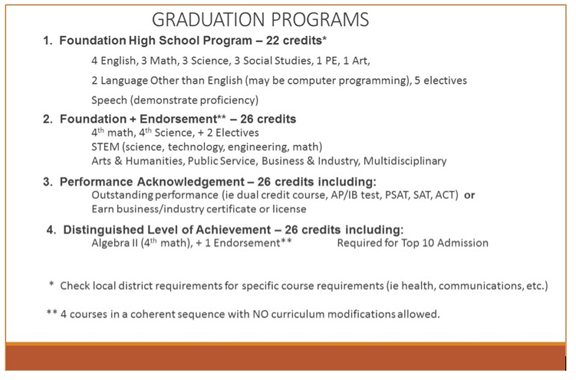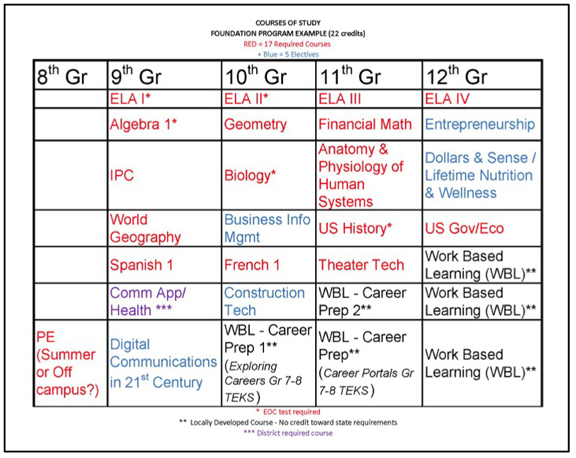Most typical students begin planning out their high school courses in 7th grade. It should not be any different for students with disabilities. Planning the course of study during junior high and high school is an important step in planning for the future. The decisions you make, along with the course of study your child pursues, will affect your child’s post-secondary plans, including college and career readiness.
Most school districts offer a course catalog that lists the classes available within the district. Some classes may only be offered at certain campuses. Some junior high classes may be offered for high school credit in the eighth grade. The nice thing about the course catalogs is they usually have a worksheet to help your child map out the classes that are required for graduation. Often within the IEP, there is also a worksheet devoted to this process.
Students with disabilities should be following the same course of study that other students are required to take based on their graduation plan. If your child plans to attend college or university, they will also need to look at any required course work for entrance into that university along with the graduation program.

It is extremely important for you to help your child map out the four years of required courses so that you know where there is room for electives, etc.
This picture is an example of how a student (who may be interested in participating in off-campus work based learning opportunities in his/her senior year) would plan their four years of high school.

What classes are offered at the high school that can develop the skills needed to reach the post-secondary goals? Remember, you do not have to look to the special education department for these opportunities. Many high schools offer classes in cooking, money management, and other related skill building classes. Using the post-secondary goal examples –
– Rachel will need to take courses of study to meet the Texas A&M requirements for entry, especially if she is interested in the top class rank percentage to qualify automatic admission.– Bill may want to take courses in culinary arts.
– Jan may decide to enroll in computer classes that will help her create a website or manage the accounting for her business.
– Chris may decide to take courses in agricultural mechanics in order to learn how to use tools and equipment effectively.
Remember, that in order to earn an “endorsement”, the ARD/IEP committee will have to ensure that the course, with modifications is rigorous enough to earn the endorsement. Even if your child cannot earn an endorsement in the class, your child can still take any courses related to an endorsement path despite having modifications.
By having access to the general curriculum, your child may come away from those classes learning more than everyone expected. It may also bring your child closer to achieving their post-secondary goals.
Course Substitutions
There should not be any course substitution for the Foundation program. For some students, fulfilling the requirements of the Foundation program may not be possible in the same manner as other students without disabilities. The ARD committee (which you are a part of) or the 504 committee will determine if your child cannot complete the Language Other than English (LOTE) or Physical Education (PE) requirements.
A credit allowed to be substituted for the LOTE or PE credits may NOT be used to satisfy any other graduation credit requirement. For more information, see Course Substitutions.
Requirements for Instruction on Proper Interaction with Peace Officers
Parents should be aware of a new rule, Requirements for Instruction on Proper Interaction with Peace Officers, that became effective Aug. 27, 2018. This rule requires schools to provide instruction to students in grades 9-12 on proper interaction with peace officers during traffic stops and other in-person encounters.
The new requirement applies to any student who enters grade 9 in the 2018-2019 school year and thereafter. This instruction is important to all students, including those with disabilities. The student’s IEP should include goals on learning how to communicate with officers about their disability and knowing their rights.
Schools must use materials developed by the Texas Commission on Law Enforcement, the SBOE, and TEA when providing this instruction to students. These materials include a 16-minute video and an instructor’s guide, which are available on the Texas Gateway.
Completion of the required instruction on proper interaction with peace officers must be clearly indicated by the school on the student’s Academic Achievement Record (Transcript).
Academic Achievement Record
The student’s graduation plan and all coursework will be recorded in his or her Academic Achievement Record (AAR), or official high school transcript. Every course your child takes will be reflected in the AAR. Carefully monitor the courses your child takes from the very beginning of high school, and maintain a vision of what you would like for your child’s AAR (transcript) to look like when Graduation Day arrives. Ultimately, the AAR is the key to your child’s future.
Once post-secondary goals and a course of study are developed, then the ARD Committee, which includes you and your child, can:
– Create annual goals that support a student reaching the post-secondary goals
– Discuss additional transition services that might assist a student in reaching the post-secondary goal.
When you have a vision for the future, you will be able to determine what your child will need to learn in high school (and earlier) to prepare for graduation.
Resources:
Texas Project FIRST
- Coordinated Set of Activities
- Graduation Programs
- Graduation Options
- Guardianship & Alternatives
- Postsecondary Goals
- Related Services & Transition
- Transition in the IEP
- Transition Resources
Texas Education Agency
- Graduation Requirements
- Graduation Toolkit
- Online College & Career Readiness Resource Center
- Pathways Initiatives
College and Career Readiness (CCR)
- Texas College & Career Readiness Standards (pdf)
- Texas College & Career Readiness Support Center Planning Guide
- College & Career Readiness & Success Center
Course of Study (Video) with Ed O’Leary of Cutting Edj Consulting resources
Helping Educators, Parents, and Other Stakeholders Understand Post School Outcomes, Course of Study, and Coordinated Set of Activities (2009) by Ed O’Leary & Wendy Collison – This document explains IDEA transition requirements and includes sample transition activities and strategies that can be used by the IEP team to determine needed transition services to address the student’s postsecondary goals.
Transition Assessment & Goal Generator – Zarrow Center for Learning Enrichment




